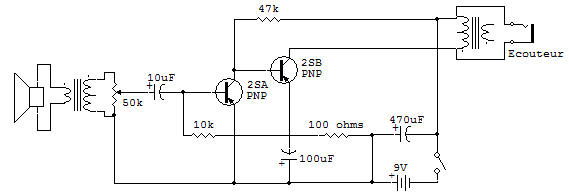

Amplifier with two close-coupled transistors

This project is an amplifier for 2-coupled transistors which has a very high gain. It is used in this project with the speaker connected as electrodynamic microphone and an earpiece as output. This arrangement and this circuit are very similar to hearing aids to modern transistors see Amplifiers section.
The sensitivity is so good that you will have to remove the speaker or headset you will experience oscillations due to acoustic feedback. This two-transistor circuit is familiarly called the "circle of two." Its name comes from the fact that the two transistors are coupled in a reaction that circle.
That is to say that the bias for a transistor (2SA) is obtained of the second transistor, while the polarization of the second transistor (2SB) is controlled by the first transistor.
The advantages of this system are numerous and include: small parts, high gain and good polarization stability.
The operation of the signal is as follows:
the signal at the base of 2SA is amplified and appears at the collector. This amplified signal is coupled directly to the base of 2SB.
The 2SB again amplifies the signal and applies it to the listener.
The coil of the transformer is used to obtain a low resistance to that, while exhibiting a very high impedance to the AC signal.
You can use a VOM to check for bias voltages that (which are obtained as below) The voltage of 9 volt battery is divided by the resistance of 4.7K and the effective resistance between the E-C 2SA, to obtain a low value at the base of 2SB.
The transmitter 2SB current that passes through the 100 ohm resistor because the development of a low voltage across the resistor. This voltage is passed to the base of 2SA through the 10K resistor as polarization-base voltage. This polarization control the effective resistance between C-E of 2SA.
The stabilizing effects can be described as follows. If the current 2SB tended to increase (possibly due to an increase in temperature), the tension rose at the base of 2SA would also tend to increase. This polarization-base voltage increased to 2SA cause a drop in effective resistance to C-E. This would cause the 2SA collector voltage drop (and the base voltage of 2SB). This core voltage decrease of 2SB is a bias reduction that tends to reduce the current near normal. 100 uF capacitor prevents backlash explained above to reduce the signal gain and the reduction of change of the DC voltage.
